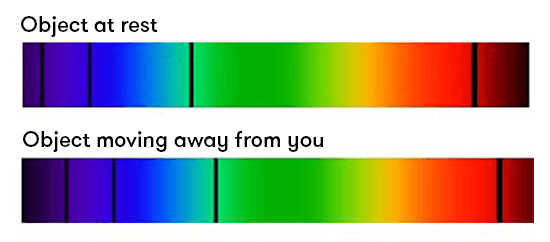Using the Doppler Effect, Astronomers Can Determine a Star's
All known elements emit and absorb detail wavelengths of lite, which is role of the electromagnetic spectrum. By studying the wavelengths of low-cal (as indicated by 'lines' within the electromagnetic spectrum) emitted by an object in space, astronomers tin get a range of information. One thing they examine is the change in position of lines in the spectrum from a star—this tin can tell astronomers how far away the star is, whether it is moving towards or abroad from us and how fast information technology is moving.
When looking at the radiation emitted past distant stars or galaxies, scientists meet emission spectra 'shifted' towards the red end of the electromagnetic spectrum—the observed wavelengths are longer than expected. Something causes the wavelength of the radiation to 'stretch'. Just rather than an bodily change in the wavelength, this phenomenon was something similar to the Doppler effect—they simply appear stretched relative to the observer. The further away an object is, the greater the shift.
The Doppler upshot
The noise of a siren or a automobile speeding past sounds higher in pitch the closer it gets to you and lower equally it moves away. This is called the Doppler event, where waves, in this case sound waves, modify in frequency and wavelength equally the source moves towards you lot (higher frequency, shorter wavelength) or abroad from you (lower frequency, longer wavelength). There is no actual change in audio; the auto isn't making a different racket. Information technology simply sounds different due to the car's motility relative to you.
Doppler shift
This apparent change in wavelength can also be observed for the visible light emitted by stars or galaxies. So, if a star is moving towards Earth, it appears to emit low-cal that is shorter in wavelength compared to a source of lite that isn't moving. Considering shorter wavelengths correspond to a shift towards the blue end of the spectrum, this is chosen blueshift. In dissimilarity, the light from a star moving abroad from us seems to shift towards longer wavelengths. As this is towards the red stop of the spectrum, astronomers call it redshift.

The degree of shift can likewise give astronomers information well-nigh how fast the object is moving relative to united states. A faster-moving object has a greater shift in wavelength.
Using various measures to establish how far away the galaxies were, Edwin Hubble (and those that followed him) found that their velocity was always proportional to their distance. The ratio of the ii became the famous 'Hubble constant' and represents the expansion rate of the universe. But is the expansion charge per unit really constant? Apparently not … and that'south where dark free energy comes in.
Source: https://www.science.org.au/curious/space-time/how-do-astronomers-know-universe-expanding
0 Response to "Using the Doppler Effect, Astronomers Can Determine a Star's"
Post a Comment